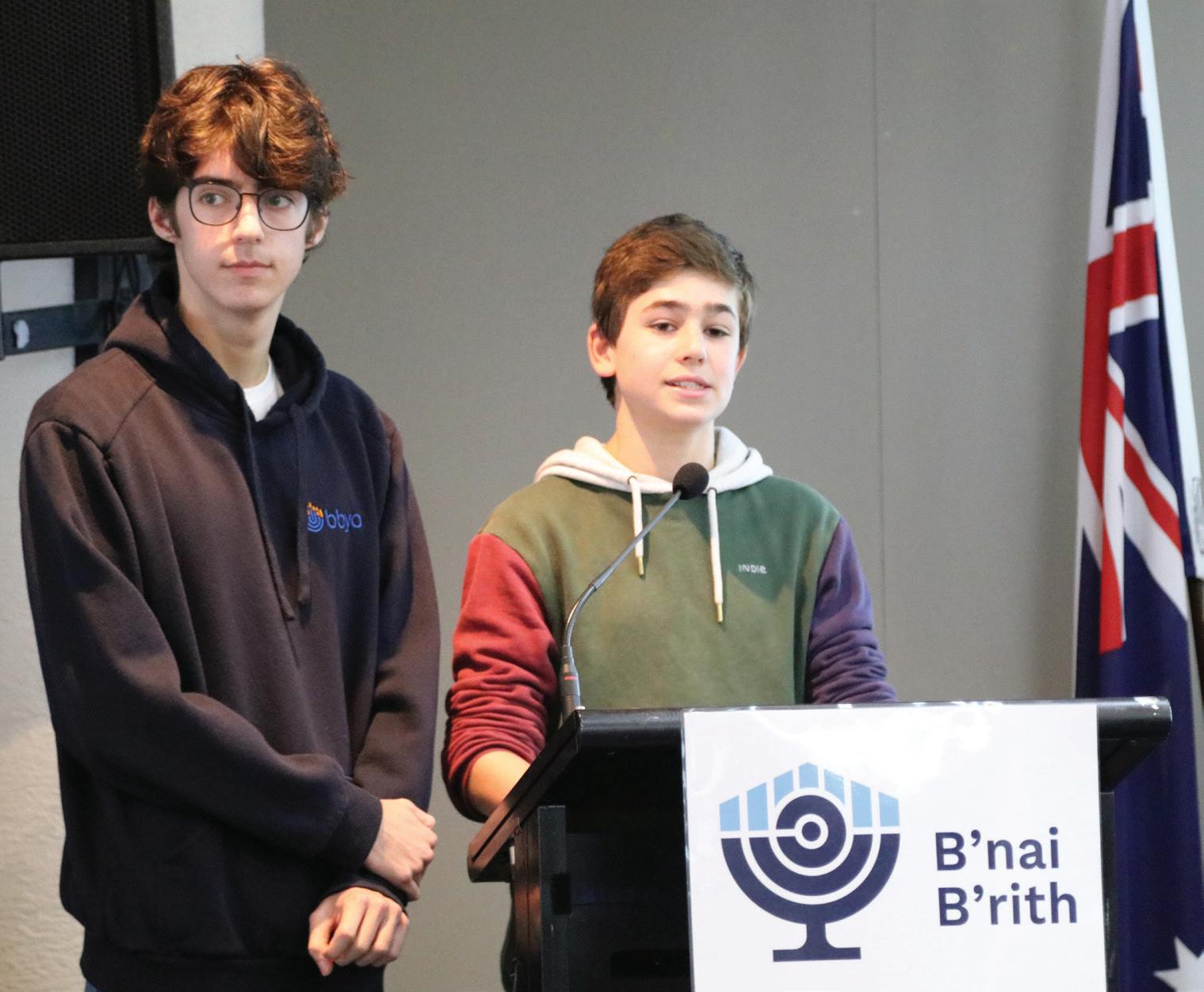
43 minute read
STANDING UP TO IGNORANCE
AROUND THE COMMUNITY
BY ORI GOLAN
Year 11 student David Loven is striking in his eloquence.
“I am very passionate about Jewish identity, my community and ensuring it is a safe one,” says Loven.
“Out of my own experience of antisemitism, we decided to address the issue. Many forms of racism stem from ignorance and a place where ignorance has no place is in the education system.”
During B’nai B’rith’s Australia and New Zealand Triennial Convention conference, held in Melbourne recently, Loven and members of the J-Voice committee of students delivered a significant presentation.
It was based on a report they compiled (titled Being Jewish in a nonJewish School) on the experiences of Jewish students studying in government schools.
“Given a measurable prevalence of antisemitism and, in some case, the progression into physical harm, we felt it was necessary that something be done now and not later,” Loven said.
The group surveyed 74 Jewish students (from years 7 to 12) attending 13 state schools and their findings were sobering.
One in three had experienced discomfort at their school due to antiIsrael comments, Jewish stereotypes or Jewish jokes. Holocaust studies were either tokenistic or not undertaken at all. “During COVID-19 and lockdown, we saw the progression of antisemitism online,” Loven said. “In the brief moments that we were able to return to school there were rockets aimed by Hamas at Israel, yet many people were bringing it up and voicing anti-Israel opinions; it was a very uncomfortable environment.”
Last year, the group was invited to give a presentation on their report to Victoria Education Minister James Merlino. “We expected it was just going to be him, but there was such an overwhelming response. Ministers who were not even part of it came to listen and propose ideas or express an interest in being involved. It exceeded all our expectations, Loven said.
The Victorian Department of Education has now begun implementing Holocaust education as a mandatory and full unit as part of the curriculum. To that end, they are collaborating with Yad Vashem in Israel to develop a Holocaust education program.
“It was something that we wanted and needed for the community,” said Loven. “The fact that it was implemented so swiftly, astonished us.”
In June, Victoria become the first Australian State or Territory to ban the public display of the Nazi symbol in recognition of its role in inciting antisemitism and hate.
And more changes are afoot to combat ignorance, antipathy and discrimination.
The Victorian government has pledged to give $2m to Courage to Care, a B’nai B’rith project aimed at educating school aged students to be upstanders in the community.
Standing up to ignorance and hatred
From left: David Loven and Nathan Loyer presenting at the B’nai B’rith ANZ Triennial Convention (photo by Vivienne Radomsky)
J-AIR 88FM
Listen Anywhere, Anytime



AROUND THE COMMUNITY
BY RABBI YAAKOV GLASMAN ST KILDA HEBREW CONGREGATION
“I've learned much from my teachers. I've learned even more from my colleagues. But I've learned the most from my students” (Rabbi Hanina – The Talmud).
Judaism venerates our teachers and elders – and so it should. But the above truism opens our eyes to a radical idea that was virtually unheard of in the era it was coined. It says that young people can be elders too – that students can also be teachers.
Given the Talmud was compiled in an era when young people were seen as chattel, this adage is as bold as it is empowering.
The Talmud is alerting us to the need for communal leaders to focus on new and innovative paths for youth engagement. It recognises that every generation is different and each demands a personalised approach. Accepting that the youth of today see the world through an entirely different lens than their forebears – and that there is so much we can learn from them – is key if we want to remain relevant as a community.
Gone are the days when boards and roof bodies could “tick the youth box” by inviting a token young person to the table to represent their peers. Today’s youngsters don't need our invitations. They're creating their own brand and it's up to the rest of us to choose whether or not we want “in”.
I spend many hours each week engaging young members of my congregation and am in touch with a wide spectrum of young Jews, ranging from teenagers to young adults. It's not difficult to see how much their thinking has changed and how grossly inadequate old models (which may well have worked in the past) are in today's rapidly changing world.
But change in the youth’s mindset isn't informed by their age, as much as it is by their societal influences. Today's Gen Y for instance (to which I belong) has a fundamentally different outlook to the generation that grew up in the 1950s. This is because we are products of our environment; our “weltanschauung” is molded by the values of the society in which we live.
Therefore, it is no wonder that today's youth think differently. Society has moved away from hierarchical power structures. Instead, is has shifted towards empowerment of the individual. As a direct result, young people are paving their own path towards personal fulfilment and self-actualisation. And, in so many cases, they're doing an outstanding job.
Some months ago, a female congregant lamented to me that her son didn't join her at “our shule’s beautiful Friday night services” because he preferred attending the Mount Scopus minyan with his mates. I reassured her that I too would love nothing more than to see traditional shule pews brimming with youth. But if in place of following a service at my synagogue they are leading a service in theirs, that's an empty seat I view as a win.
It is these and many other success stories that fill me with hope of a bright future of emerging Jewish leaders. Indeed, I feel humbled to be part of a community of young Jews who are finding their voices. And, like Rabbi Hanina, I am proud to call them my teachers.
Our youth are our future
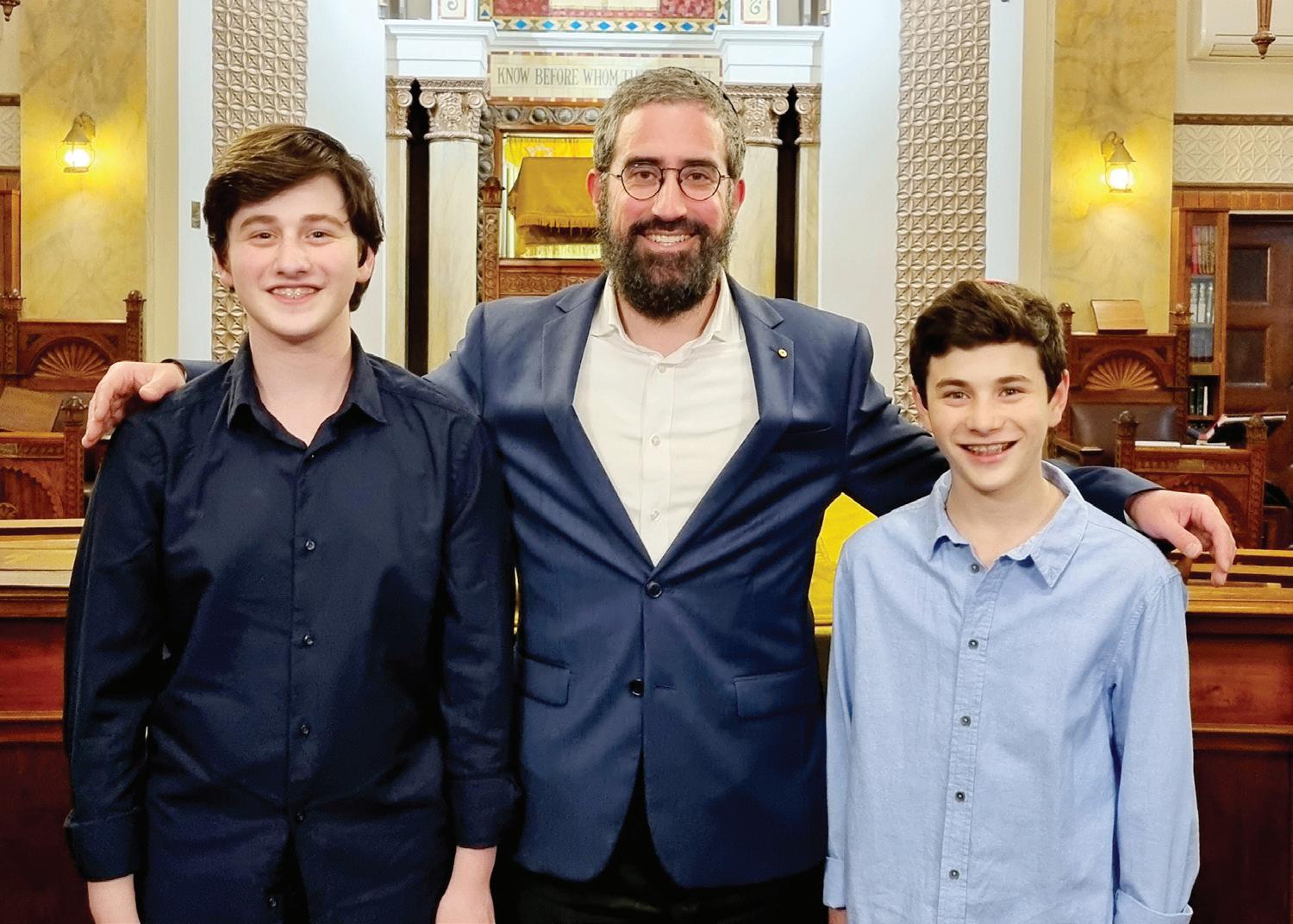
From left: Isaac Itescu, Rabbi Yaakov Glasman and Alex Itescu. Isaac and Alex are junior members of the St Kilda Hebrew Congregation.



AROUND THE COMMUNITY
JEWISH INTERNATIONAL FILM FESTIVAL
Antisemitism and racism capture attention in Armageddon Time
A new, sensitive, coming of age story highlighting the African American and Jewish experience is a vehicle to propel two bright young actors onto the world stage. Set in Queens, New York City in 1980, Armageddon Time is the opening night feature at the Jewish International Film Festival (www.jiff.com.au).
Thereafter, it will be released nationally in Australia on 3rd November. 14-year-old Banks Repeta plays sixth grader Paul Graff, born into a Jewish middle class family.
With an artistic bent, he is different to other students in his class.
His goals don’t marry with those of his parents, but he is particularly close to his grandfather, Aaron Rabinowitz, a role filled by Anthony Hopkins.
One day, grandad opens up to Paul about the trauma experienced by Rabinowitz’s mother that saw her leave Ukraine and make a new home and life in America.
Jaylin Webb, 16, portrays Johnny Davis, whose start to life has been far than ideal. From a broken home, Johnny – who is repeating sixth grade – is living with his grandmother who is increasingly ailing, suffering from dementia.
He is treated shamefully by his teacher and his aspiration to be an astronaut appears but a forlorn hope. Johnny and Paul become firm friends, against Paul’s parents’ wishes. Armageddon Time is a deeply personal story for writer and director James Gray (Ad Astra).
He revisited his own upbringing to create characters that inhabited his formative years.
Banks Repeta and Jaylin Webb told The Jewish Report that in casting them Gray was keen to see what they could bring to the table in their respective roles.
The pair bonded in the short time they had to get to know each other before filming began and that is immediately evident by what we see on screen. Banks grew up in the film industry. His father is a motion picture camera operator and his mother an actor.
Jaylin was a born entertainer who acted in plays during his middle school years and decided to transition to film during COVID-19 quarantine.
Banks says it was the dinner scenes in Armageddon Time that got him closest to what it was like being in a Jewish family.
Apart from Anthony Hopkins as grandad, Anne Hathaway (Les Misérables) and Jeremy Strong (The Big Short) are cast as Paul’s mother Esther and father Irving. “We were so comfortable with each other. We were able to be so tight and have real conversations, even when we weren’t filming.
“That was really nice because a lot of the dinner conversations (in the film) were improv (improvised),” Banks says.
Jaylin says while he is fortunate not to be able to relate firsthand to what Johnny experiences, he has family members who do.
He says he talked to them before he appeared in the film.
“They just told me about their experiences. They told me about how it affected them mentally.
“I really tried to channel that throughout those (troubling) scenes,” Jaylin says.
He would like the film to attract a broad audience “so everyone is aware of the discrimination that black people and Jewish people had to undergo”.
For his part, Banks hopes Armageddon Time reaches people that haven’t experienced the oppression the movie portrays “so they can know what it was like”.
The Jewish International Film Festival starts in Melbourne on 24th October, in Sydney on 25th October and in Brisbane on 26th October.
Opening night on the Gold Coast, as well as in Perth, Hobart and Canberra is on 27th October.

Jaylin Webb (left) and Banks Repeta in Armageddon Time
A story of oppression
ARMAGEDDON TIME REVIEW BY ALEX FIRST
It is 1980 in Queens, New York City.
Two six graders form an unlikely friendship that causes all sorts of friction.
Paul Graff (Banks Repeta) is from a good Jewish family who escaped oppression in Europe.
African American Johnny Davis (Jaylin Webb) is from a broken home. He is living with his grandmother who is increasingly ailing, suffering from dementia.
Paul is a gifted budding artist, while Johnny (who is repeating grade 6) dreams of a future with NASA.
Both fall out with their teacher, Mr Turkeltaub (Andrew Polk) and bond while being prevented from participating in gym with the rest of the class.
Paul is particularly close to his grandfather Aaron Rabinowitz (Anthony Hopkins), a principled man who thinks the world of Paul and enjoys spending time with him. One day, grandad opens up to Paul about the trauma experienced by his (Rabinowitz’s) mother that saw her leave the Ukraine and make a new home and life in America.
Rabinowitz is the glue that binds the family together.
Paul has a much pricklier relationship with his dutiful but overextended mother Esther (Anne Hathaway) and plumber father Irving (Jeremy Strong).
They have aspirations for Paul that don’t match his own desires. As the boys’ friendship develops, they find themselves increasingly at odds with authority figures. Meanwhile, Rabinowitz encourages Paul to be a mensch (a Yiddish word meaning a person of integrity and honour).
Written and directed by James Gray (Ad Astra), Armageddon Time is a deeply personal coming of age story – a layered work of fine craftsmanship.
With it, Gray has revisited his own upbringing and created characters that inhabited his formative years. The film is characterised by a series of outstanding performances, starting with newcomers Repeta and Webb.
Both inhabit their characters with distinction.
There is a vulnerability about them, which is authentic and captivating.
Paul is trying to make sense of a world where he knows he is different from other kids, while Johnny is alienated and hamstrung by racism and poverty.
In a bravura showing, Hathaway is a knockout as a mother who is both caring and impatient.
Hopkins slots comfortably into the role of a grandfather who dishes out worldly wisdom. There is much about Armageddon Time that is emotionally wrought.
It is sensitive film about love and loss, class, struggle and expectation.
Many of the scenes stayed with me long after I exited the cinema.
Armageddon Time is a movie that deserves to be seen and appreciated for its insight into the American Dream.

Banks Repeta (left) and Anthony Hopkins, two of the stars of Armageddon Time
JEWS AROUND THE WORLD
BY DR YVETTE ALT MILLER COURTESY: AISH.COM
For centuries Jews have been vital in the production and marketing of beer.
Here are eight surprising facts about Jews and the history of this popular drink.
Ancient origins
Beer-making dates to ancient times. Egyptian tombs depict pictures of beer brewing; Hammurabi’s Code, from 18th century BCE Mesopotamia, mentions beer; the ancient Greeks learned how to brew beer from Egyptians and brought this knowledge to Europe.
Ancient Israel, in contrast, favoured wine over beer. But after the destruction of the ancient Temple in Jerusalem in 586 BCE, Jews were exiled to nearby Babylonia and adopted the Babylonian taste for beer. The Talmud records four different types of beer, brewed from barley, dates, figs and beer (Pesachim 107a). The modern usage of hops, a plant related to mulberries, in beer is also mentioned in the Talmud, which notes hops’ medicinal properties of being a preservative and antiseptic (Avodah Zarah 31b).
Beer’s popularity with ancient Jews is also evident in the fact that beer is an acceptable substitute for wine in the Havdalah ceremony, marking the transition from Shabbat to the rest of the week.
Hops: a key beer ingredient
In the Middle Ages, Germany embraced beer. By law, Jews were barred from brewing the popular national drink. That didn’t change until the 1800s, but Jews became central to the beer industry in another way: by growing a flower called hops, which is a crucial ingredient in beer.
By the time the Nazis rose to power in the 1930s, Jews controlled about 70 per cent of German’s important hops industry.
Germany’s 1516 “beer purity law” mandated that beer be made only with hops, barley, yeast and water. Hops were suddenly in great demand, creating a key business opportunity. At the time, many Jews were being expelled from German cities. Resettling in the countryside, Jews began to grow and trade hops, soon dominating the industry. By the time the Nazis rose to power in the 1930s, Jews controlled about 70 per cent of German’s important hops industry.
Ironically, the purity of German beer was noted with a mark that looked decidedly Jewish – a six-pointed star, much like (though not related to) the Star of David.
Kindly Jewish innkeepers
A 1764 census of Polish Jews found that approximately 80 per cent of Jews living in villages worked in the alcohol trade, distilling and selling wine, vodka, liqueurs and beer. Poland’s vodka and beer industries grew in the 1500s, as landowners devoted more land to grow the grains needed for these drinks and set up taverns to sell them in. Many of the innkeepers who ran these taverns were Jews and seen as more sober and responsible than the general population.
So ubiquitous were these Jewish managers that the image of a kindly Jewish innkeeper became ingrained in Polish life. One example is the character of Jankiel the tavern-keeper, a wise and patriotic Jew created by Poland’s national poet Adam Mickiewicz in his work “Pan Tadeusz”.
In the 1800s, Jews found themselves gradually edged out of the beer and liquor trade in Poland by a series of anti-Semitic laws, though even then many Christian tavern owners would continue to clandestinely employ Jewish managers, who had so shaped Poland’s beer and tavern culture through the ages.
Imbibing in Colonial America
Ale in Colonial America was a popular drink, often brewed at home for family consumption. At a time when water supplies were often contaminated, beer provided a relatively safe alternative to drink. Unlike modern beers, some of these beers were less alcoholic, making them more suitable to drink regularly.
It seems that Jews in Colonial times partook of beer, as well. In his 2004 book “The Jews in Colonial America”, author Oscar Reiss provides the example of the household of Judah Hay, a middle-class Jew in New York City, who once lived with his family in a home rented from Founding Father John Jay. The family recorded monthly spending 1.3 British pounds on three barrels of beer, more than enough to drink ale every day, if they wished.
Inventing modern beer
In Germany, Jews were finally allowed to make and sell beer in 1868 and they quickly revolutionised the industry, improving beer production in Germany and beyond. Bernhard Purin, director of Munich’s Jewish Museum, who recently staged an exhibit on “Jewish Brewery Tales”, notes that “Jews in Germany (integral in the creation of Oktoberfest) were always very successful in times of modernisation and so they came into the brewing business when there was a need for modernisation”.
Jewish brewers introduced modern manufacturing methods for beer. One of the pioneers was Jakob von Hirsch, a Jewish baron, who envisioned a modern beer factory near Munich. Blocked for years by locals who resented his plans, Baron Hirsch eventually opened Planegg Castle Brewery in 1836, becoming Germany’s very first industrial-scale beer brewer.
Lowenbrau, one of Germany’s best known beer brands, was also shaped by the vision of its Jewish chairman, Moritz Guggenheimer, who was one of the first to realise the potential of moving freight by rail, and turned what had previously been a small local brewery into Munich’s largest beer exporter. By World War II, after merging with another Jewish-owned beer company, it was Germany’s largest brewer. (Under the Nazis, the company was turned over to non-Jewish owners and its last Jewish chairman was sent to a concentration camp.)
German Jews helped spread their newfound brewing knowledge outside Germany. A Jewish amateur brewer named JC Jacobson travelled to Munich in the 1840s to learn about cutting edge brewing technology. When he returned to his native Denmark, he founded Carlsberg Beer, still Denmark’s largest and best-known beer brand.
Germany’s iconic decorated beer steins, surprisingly, are a Jewish invention. Germans traditionally drank their beer from plain, unadorned steins. Starting in the 1800s, Jewish entrepreneurs began making ornate, decorative steins. The trend caught on and today beautiful beer steins are a quintessentially German art form.
Bringing beer to America
As waves of German immigrants, including Jews, poured into America in the 19th Century, they brought their taste for beer and their know-how in producing top German-style brews with them. One of the best-known beer labels founded by a German Jewish family was Rheingold Beer, started by a Jewish immigrant named Samuel Liebermann in Brooklyn in 1850.
The current explosion of craft-beer brewing in America has included a high number of Jewish producers making boutique beers.
Beer in the Promised Land
Israel might not have been known for beer in ancient times, but today the Jewish state boasts a cutting-edge beer scene, with high quality microbreweries and annual beer festivals in Jerusalem and Tel Aviv.
The first beer company in modern Israel was a French-Israeli venture known as Palestine Brewery Ltd, opened in 1934 in the Israeli town of Rishon Le Zion. The company produced a light lager and a root beer-like drink called Nesher Malt. In the 1950s, Rishon Le Zion became home to another beer company, Cabeer Breweries, that invented Goldstar, a German-style pale lager. In 1968, Maccabee started producing a Czechstyle lager that quickly became Israel’s best-selling beer.
Israel’s first licensed microbrewery, Dancing Camel, made a startling discovery when it started producing beer in 2006: remains of a 5,000-yearold brewery were discovered near the company’s modern Tel Aviv brewery. The company embraced Jewish history, even creating one beer made with date honey and made according to a 4th century Jewish recipe, and dozens of other Israeli breweries followed suit.
Today, Israel is home to about 40 microbreweries. Israeli brewers have invented gluten-free beer, produced the world’s first date ale and have created special beers that capture the flavours of the Jewish state, such as pomegranateflavoured beer made for Rosh Hashanah or beers flavoured with etrogs.

Jews and beer
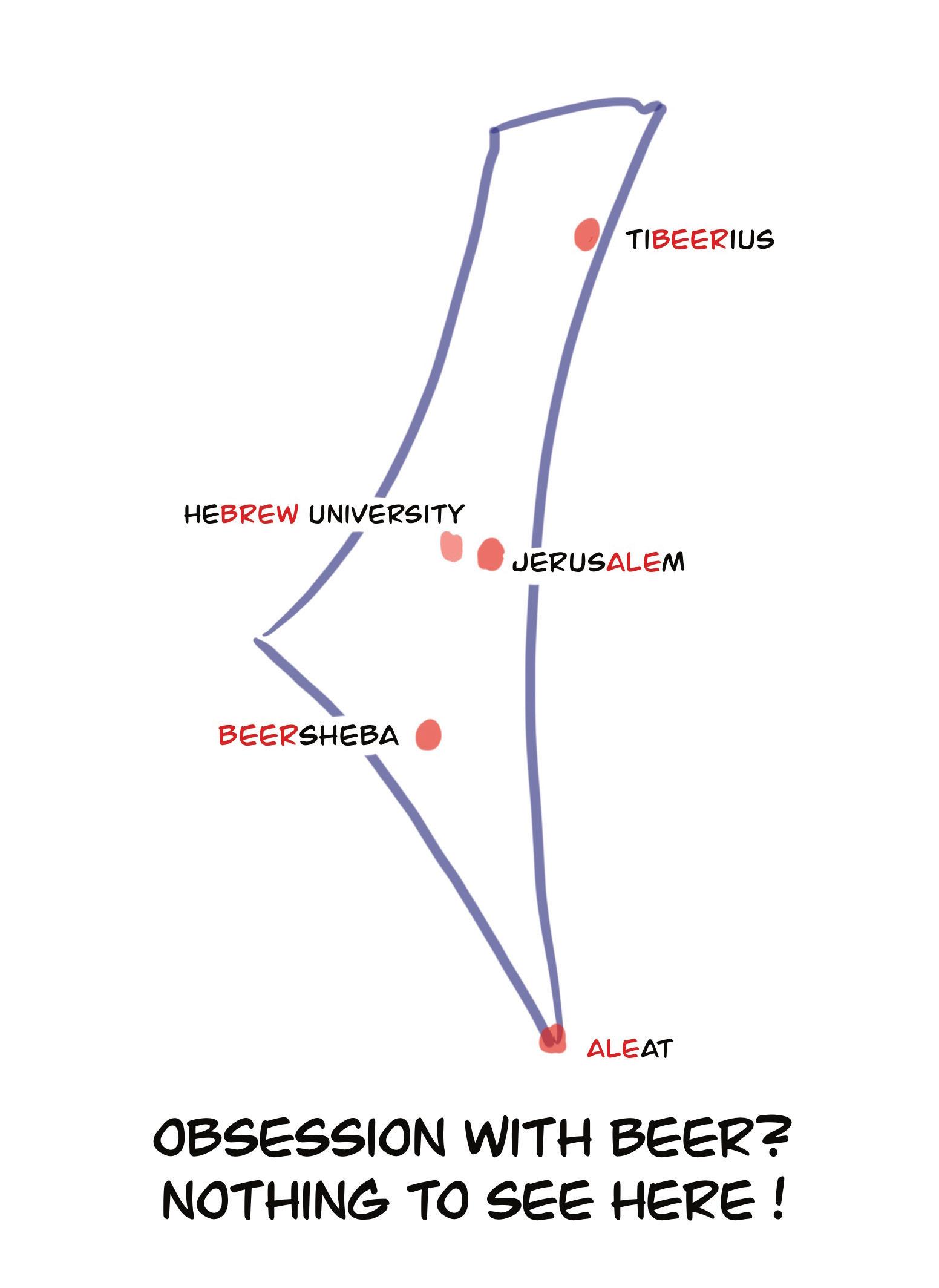
ISRAELI
NEWS Putting the boot in
BY NOMI KALTMANN COURTESY: WWW.PLUS61J.NET.AU
Nomi Kaltmann talks to the captain of the Tel Aviv Cheetahs and finds out how Australian Rules Football has gotten a foothold in the Middle East.
Shir Shalev, an Israeli who has never visited Australia, is not necessarily the first person you would pick as the captain of the Israel AFL team. Shalev’s love of Aussie Rules was sparked by accident a few years ago when he was studying in Jerusalem. One day he happened to walk past a group of Israelis and Arabs from the Jerusalem Peace Lions playing footy in the local park.
“They offered me the opportunity to join in and I loved the game,” Shalev says.
Athletic, the 26-year-old has always enjoyed sport. “I have lived with a ball in my hands or on my leg since forever. I play all sports including soccer, basketball, volleyball and tennis.”
Shalev was born in Israel and grew up on Moshav Gea in the south of the country, where he did not meet any Australians. “I still remember the first time I played in Jerusalem. They said ‘it is not American football – you handball it’. I did not buy it. I did not know footy at all. I did not know what they were talking about. I said: ’that’s not real’.”
From this chance encounter, Shalev became hooked on the game and would play weekly with the team in Jerusalem. A year later, when he and other players moved to Tel Aviv, he decided to start a team – the Tel Aviv Cheetahs – hoping that there would be interest. From there, it just grew and grew. These days, the Tel Aviv Cheetahs are the only AFL team in Israel, which represents the country at international AFL tournaments.
The genesis of AFL in Israel was a 2008 joint initiative by the Peres Center for Peace and its Palestinian partner, the Al Quds Association for Democracy and Dialogue. The team was created with 13 Israeli and 13 Palestinian players, with the aim of using footy to help increase dialogue between Israelis and Palestinians and to encourage peaceful co-existence. While the AFL Peace Team ceased operating around 2011, AFL Football caught on in Israel, with a small but dedicated group of Israelis playing every week. The Israeli team, captained by Shalev, is part of the AFL Europe League and competes in the AFL European Championships. The most recent championship was held a few months ago in Edinburgh, Scotland, where the Israelis finished eighth out of the 16 teams that competed.
“Most of the Tel Aviv team are Israeli guys with a connection to Australia – people who have family from Australia or have lived there for a bit. There are also a few Israelis who are like me,” Shalev says.
On average, about 15 players come to weekly training sessions in Tel Aviv and they are connected through a WhatsApp group.
Avi Gillis, 31, is a member of the Cheetahs and is grateful for the good times he has had with the team. It helps him retain a connection to Australia, from where his family made aliyah more than 25 years ago. “The way I got to know footy is through my Aussie family. Most of my mother’s family is in Melbourne; they are big St Kilda fans. I grew up with a bit of footy. I always followed St Kilda,” he says. Gillis is still working on honing his skills. “I am all right. I have decent kicking skills and pretty good defensive instincts. I don’t find the ball that much; I’m usually tracking other players. I am not the strongest player overhead, but I do my best trying to win on the ground.”
He chose to play AFL in Israel because he enjoys the sport and camaraderie it encourages. “The nice thing about playing footy in Israel is that it is unique there. It is not well known. It is a fun thing to introduce to people, plus it’s a slice of my heritage,” he says.
Playing with Israelis has extra benefits, he says. “Israelis bring a unique approach to footy. They are very fast and fit. That is common in footy in Australia, but in Europe that is our strength. That is how we get our wins. We are a small and quick team. Usually, we give away a fair bit of size, but we make up for it with speed,” he says.
For Trent Smythe, the chair of AFL Europe, who now lives in London, the excitement that people across Europe have from participating in Aussie Rules makes his role totally worth it. “The spirit of the game that is AFL means that players understand the concept of mateship and friendship,” he says. “It is a very old game. The good thing about it is that many of the endearing qualities of the game are quite Australian – that sense of mateship and community. When you see people playing AFL in another country, you feel that we are exporting some of that culture and others get to experience it.”
It’s something Shalev, as the captain of AFL Israel, understands. “It’s the best sport in the world, but the world doesn’t know about it yet. Still, the word is spreading,” he says.
Footy also represents the need for discipline in a wide range of areas. “With footy, you have to be good at everything. Kicking. Handballing. Good with your feet and hands. It’s super fun. You need to be fit but also strong,” he says. “I used to be a soccer fan and I used to watch it, but now I only watch footy. I can’t watch soccer anymore, it’s too slow.”

Shir Shalev in action on the football field


CONSIDERED OPINION
BY LUBOMYR LUCIUK
Despite their country’s historical record, Ukrainians have, often as not, been told they don’t exist, have never existed, and, more alarmingly, should not exist. Ukraine is not new. As my colleague Professor Paul Robert Magocsi recently demonstrated in an incisive essay, Ukraina Redux, Ukrainians have attempted to forge a state of their own over several centuries. Repeatedly their struggle for independent statehood has been thwarted by predacious, indeed rapacious, neighbours. This first happened in the 17th century, then several times in the 20th. And it’s happening again.
Nay-sayers have sometimes insisted Ukraine was nothing more than an Imperial German construct, staged during the First World War to undermine the Tsarist Russian Empire. Others claim Ukraine was Lenin’s project or maybe wasn’t even truly around until Stalin crafted it in the wake of the Second World War.
Confusingly, Vladimir Putin, the KGB man in the Kremlin, has claimed he “respects” Ukrainians even as his legions deliberately target Ukraine’s civilians and infrastructure. This is the same fellow who, not long ago, spouted off about how the Ukrainian state has no raison d’être as so-called Ukrainians are nothing more than misguided “little Russians”. After delivering that epistle Putin assigned himself the duty of dragging them back into a supposed Russian Mir (obviously without much success). And, lest this commentary seem too partial, don’t forget the many Western specialists who blathered on about how eastern Ukraine’s Russianspeaking inhabitants were Moscoworiented, not at all patriotically Ukrainian. Reality has demonstrated otherwise. What many predicted would be a 100hour war has become a Ukrainian war of independence. Those of Putin’s ilk who didn’t think Ukraine exists now know better.
Ukraine returned to its rightful place in Europe with the disintegration of the Soviet Union in 1991. Soon thereafter, trusting in what they believed were the guarantees of the USA, UK, and yes, even the Russian Federation, Ukraine gave up its nuclear arsenal, assuming that would ensure their country’s territorial integrity and political independence. They have since learned otherwise, the hard way. At the time I tried to warn them about their naiveté but they didn’t listen. The 1994 Budapest memorandum has since proven to be a guarantee of nothing at all. If Ukraine had retained
even a few tactical nuclear weapons Moscow’s men would not have been so cocksure in planning their genocidal war of aggression against Ukraine and Ukrainians, nor would Putin today be trying to bully the world by threatening Armageddon. Meanwhile, countries like North Korea, Israel, Pakistan, India, and perhaps even Iran, have been reminded of why disarmament is for dummies.
Ever since the happy day that the Soviet empire exfoliated, many countries once described as the “captive nations” of the USSR and Warsaw Pact have voluntarily joined the European Union and NATO. This was not the result of some nefarious geopolitical conspiracy, nor did this growth represent any kind of existential threat to the Russian
Federation. What actually happened was that the “east” came “west”, quite willingly, indeed anxiously, doing whatever was necessary to escape the clutches of the Kremlin. Doubt me? Just ask a Pole or an Estonian whether they miss the “good old days” of Soviet domination. Then question a Georgian about whether her country should join NATO. The answer is yes. And just this June Ukrainians celebrated the good news that their country has been accepted as an EU candidate member.
Haven’t Ukrainian sacrifices since then also earned them a place in NATO? That is what President Zelensky said a week or so ago when Ukraine applied for an accelerated admission. Thankfully, several NATO member countries, including Canada, Poland, and the three Baltic states have expressed support. As for Russian sensitivities on this issue – ignore them. Moscow shouldn’t have a say about what Kyiv does, because Ukrainians aren’t Russians, never were, never will be and have every right to decide their own fate. Once in NATO they will repay the Free World by continuing to defend the gates of Europe, a battletested bulwark blunting the designs of a rogue Russian state that will itself remain beyond the pale of civilisation for years to come. Unless, of course, the Russians have a real revolution and rid themselves of those who led them into perdition. If that ever happens Russia might still be redeemed. But I’m not hopeful.
Ukraine is not new
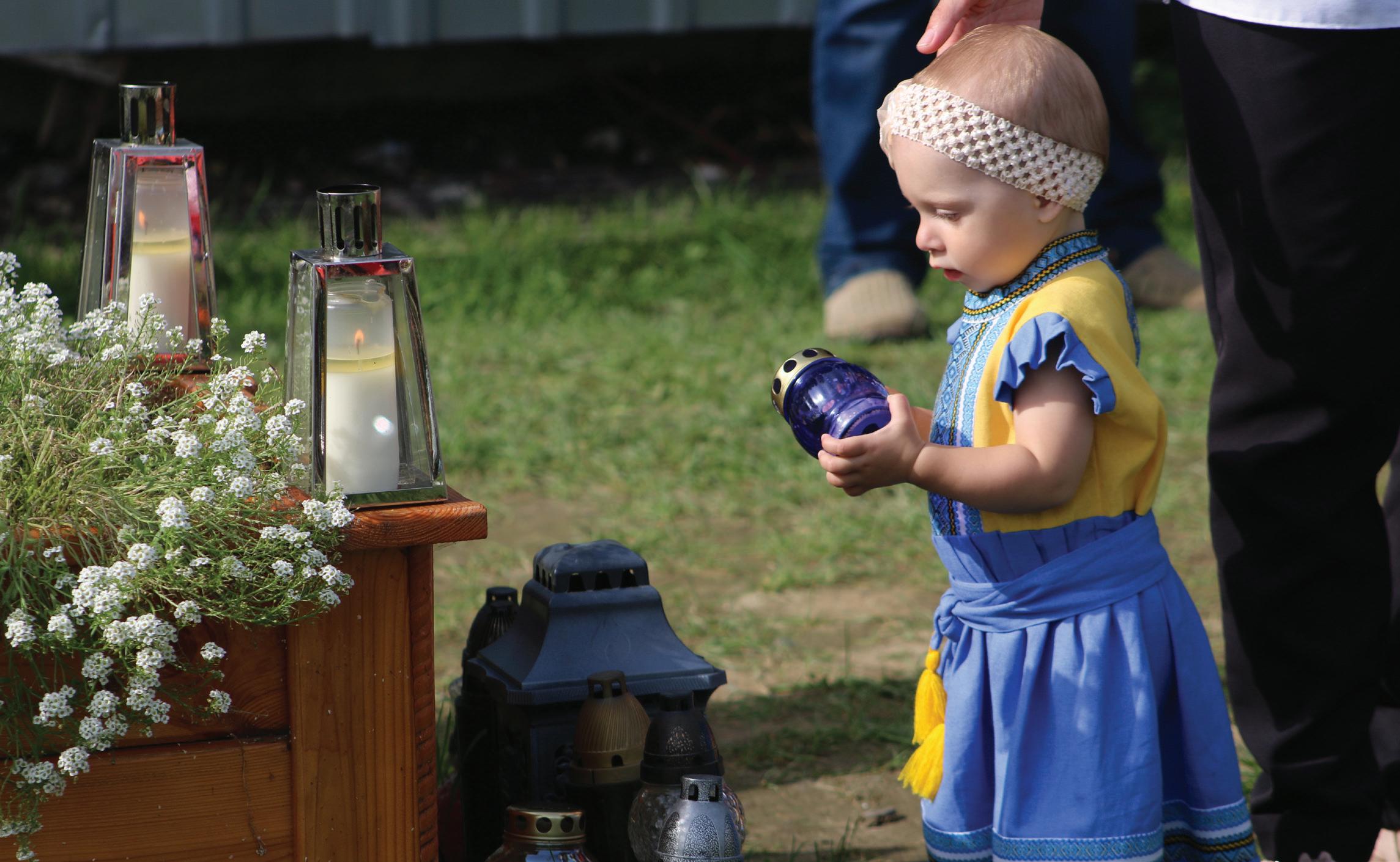
Judaica quiz answers
1. 1817 2. He was a Quaker 3. Habima 4. b) Historian. He wrote the 18 volume work, A Social and Religious History of the Jews 5. The Vatican or Vatican City, he was better known as Pope Pius XII 6. Herzliya Pituah 7. Koren Publishing 8. Woody Allen 9. Joseph (Genesis 50: 26) 10. Ladino, otherwise known as JudeoSpanish 11. All three statements are correct 12. Sefer Ha-Ikkarim – The Book of Principles 13. The music was written by Frederick Loewe, the lyrics by Alan Jay Lerner 14. Albert Einstein 15. Samson’s mother 16. It was named after Major Uziel Gal, its designer 17. Marc Chagall 18. Rav Nachman of Bratslav 19. The earliest form of this prayer contained a sentence, “For they worship vanity and emptiness, and pray to a god who cannot save.” For technical reasons, this sentence was taken by the Church as a direct reference to Christianity. In vain did the rabbis defend the sentence on the grounds that the expression came from the Book of Isaiah, or that the whole prayer came from Joshua, and therefore must predate Christianity. They also reasoned that if the prayer was attributed to a Babylonian sage known as Rav, who lived in 3rd Century Babylonia (Persia), that he never encountered a Christian. Nowadays that line has been restored in certain Siddurim 20. Gwyneth Paltrow 21. 30.4 22. The Marais is Paris' most famous Jewish neighbourhood, also known as the Pletzl—Yiddish for little place. This area has been home to Jews since the 13th Century 23. Palm Branch (Lulav), Citron (Etrog), Myrtle (Hadasim) and Willow (Aravot) 24. Maccabi Haifa 25. Isaac Bashevis Singer
Spelling bee answers
Jewish term – KAPOTEH. Here is a list of some common words (yes, we know there are more words in the dictionary that can work, but these words are common to today’s vernacular): KEEPAH, KEEPOT, PHOTO, POPPET, POTATO, TEAPOT, TEEPEE (TEPEE). Questions/comments – email Yoni at koshercroswords@gmail.com
CONSIDERED OPINION
BY TOMASZ CEBULSKI
Why Israel will not support Ukraine militarily by November 1st, 2022
The elections, yes again, in Israel are planned for November 1st. By this time no Israeli politician will declare military help to Ukraine because it would have been political suicide in the next touchand-go electoral and coalition-building cycle.
A quick look at the electorate
Between 1989 and 2006, about 1.6 million Soviet Jews and their non-Jewish spouses and their relatives, as defined by the Law of Return, emigrated from the former Soviet Union. About 979,000, or 61 percent, migrated to Israel. Another 325,000 migrated to the United States, and 219,000 migrated to Germany.
That makes a large electorate block and even if many of those were from the Ukrainian SSR their identity was shaped by Soviet Russia.
Today the estimates are that there might be 1,300,000 Israelis of SovietRussian descent.
Out of 50,500 new Israelis in 2022 under the Law of Return there were 40,000 new Israeli citizens recognised making an aliya from the conflicted countries of Russia, Ukraine, and Belarus. Russia provided half of 2022’s new Israelis, with 23,789 documented immigrants. Ukrainians taking on Israeli citizenship followed with 13,097, and a much smaller number — 1,316 — of Belarussians.
There are still over 100,000 Jews in Russia and the July 2022 suspension of the activities of the Jewish Agency by the Russian government send them a rather worrying signal.
A quick look at the regional geopolitics
Russia largely militarily controls the chaos in Syria to the level that for the last month the IAF didn’t have to commit itself to a single mission on that territory. The last mission was on September 17th, which targeted Damascus International Airport and killed five Syrian soldiers. Israel and Russia have a deconfliction mechanism to prevent unnecessary friction during IAF operations.
The deconfliction mechanism between the two countries continues to work even with the new deployment of Russian forces in the region due to war in Ukraine. All of the IAF operations in Syria are aimed at the containment of Iran’s influences, thus the Iranian regime’s involvement with Shahad 136 drones bombarding Ukrainian cities shall bring a pivot in Israeli policy. The planned deliveries of Iranian Fateh and Zolfaghar ballistic missiles to Russia to be used against Ukraine are even more alarming.
It is generally known where the production of those weapons is organised and there will be no better time to destroy those production centres.
Netanyahu’s ungrounded argument that weapons shall not be delivered to Ukraine because they may end up being traded to Iran is mischievous but it speaks to the emotions of the Israeli electorate before elections.
A quick look at the history
Interestingly out of 14 people who held the office of the Israeli Prime ministers, six were born in the nowadays Ukrainian or Belorussian territories. Those were Moshe Sharett, Levi Eshkol, Golda Meir, Menachem Begin, Yitzhak Shamir and Shimon Peres. Moshe Sharett was born in Kherson, which is just about to be liberated by the Ukrainian army marking another low in the Russian army efforts of the last seven months.
The historical parallels of a Jewish leader like the Ukrainian president defending universal values can be quoted endlessly and all of those are at the very foundation of Israeli identity. Observing the Holocaust monuments of Babyn Yar in Kyiv or Drobytsky Yar in Kharkiv shelled by Russian artillery in search of civilian Ukrainian victims presents the full futility of the “Never Again” political slogan.
The Israeli Diaspora Affairs Minister Nachman Shai tweeted on October 16th: “There is no longer any doubt where Israel should stand in this bloody conflict,” wrote Shai. “The time has come for Ukraine to receive military aid as well, just as the US and NATO countries provide.” This was immediately paired with the threatening Telegram response by Dmitry Medvedev, an ex-Russian president and member of the security council. “Israel seems to have decided to supply weapons to the Kyiv regime. That would be a very rash decision, for it would damage all the interstate relations between our countries.
He said Israel might as well recognise [Stepan] Bandera and [Roman] Shukhevich as its heroes. Bandera was the leader of the Organization of Ukrainian Nationalists (OUN), and Shukhevich led the Ukrainian Insurgent Army (UPA). Both organisations were involved in the ethnic cleansing of Jews and Poles in Ukraine under German Nazi occupation. As a result of this exchange, Benny Gantz and Benjamin Netanyahu took a position against the military support for Ukraine.
The pragmatism that may cost
The call for those politics will come after the elections on November 1st. As for now, Israel still sits on a fence being paralysed in its decisions by the perpetual electoral mode the country experiences. November 1st, 2022 will bring the fifth Knesset election in the last four years. In May 2022 Israeli pragmatism went as far as banning its military partners in some Baltic states and Germany to transfer the Spike ATGM missiles to Ukraine. This makes an interesting policy for a country that is a beneficiary of 3.8 billion USD annually from US military aid. The side the US is taking in the current Russian war against Ukraine doesn’t have to be guessed.

RABBINIC THOUGHT
RABBI DANIEL RABIN
Australia's telecommunications industry is worth $35 billion dollars. Yet while we have incredible communication tools at our fingertips, we are seeing a decline in the quality of communication between people.
Communication issues are the most common concerns brought to psychologists and couples' counsellors. As part of my premarital counselling service, I emphasise the importance of creating a harmonious and enjoyable relationship through healthy, robust and respectful communication.
We can all work on improving our communication with our significant other and, for that matter, with anyone else with whom we wish to communicate. In Hilchot Yesodei Hatorah (7:6), the Rambam highlights the difference between Moses' method of communicating with God and the ways of the other Prophets. From these teachings, I would like to suggest how we can more effectively and successfully communicate with our loved ones.
Moses spoke "face-to-face" with God (Devarim 34:10), so to speak. Be sure to talk the same way with your partner. Look them in the eyes and maintain eye contact to show that you value and appreciate them. My wife and I attended a couple's retreat weekend a few years ago as part of a program run by our shule. Participants were asked to sit face-to-face and stare at each other for two minutes. No words were spoken. The 120 seconds felt particularly long, yet the intensity and connection were heightened. Couples should practise these skills. It will certainly enhance their communication with one another.
While other prophets were asleep during Moses' conversation with God, he remained awake. Communication requires people to stay in the moment. It is not unusual to listen to someone speak and fail miserably when asked to repeat what they said. Let the other person know that you care about them by being present, staying attentive and showing an interest in what they have to say.
When we speak, we should support, inspire, uplift and calm the other person. When our communication leads to unhealthy levels of anxiety, argument or animosity, we are not communicating well. It does not mean there will never be an argument, but it is a pointer to the fact that we should be mindful about the words we use. Many people do not think before they speak. If you stop and think about the words you are choosing, there is a much better chance that the dialogue will enhance the relationship rather than damage it.
We are told that Moses was always available to God. In today's fastpaced world, filled with meetings and distractions, it is not always easy to be available to those we love and care for when they need us, but perhaps we can work on that. I remember at time that I was in a meeting with dignitaries when one of their phones rang. They looked at it and said, "That is my wife calling. I've got to take this.". Then they added that the only time they would answer the phone is if their wife or children called. This type of message lets the other person know that the relationship is valued. Isn’t it great to know that someone is always available for you when you really need them?
So, I remain hopeful that just as Moses had profound and meaningful communication with God, we can work on our communication with significant people in our lives. This will not be worth $35 billion. Rather, it will be priceless.
Improving our communication skills
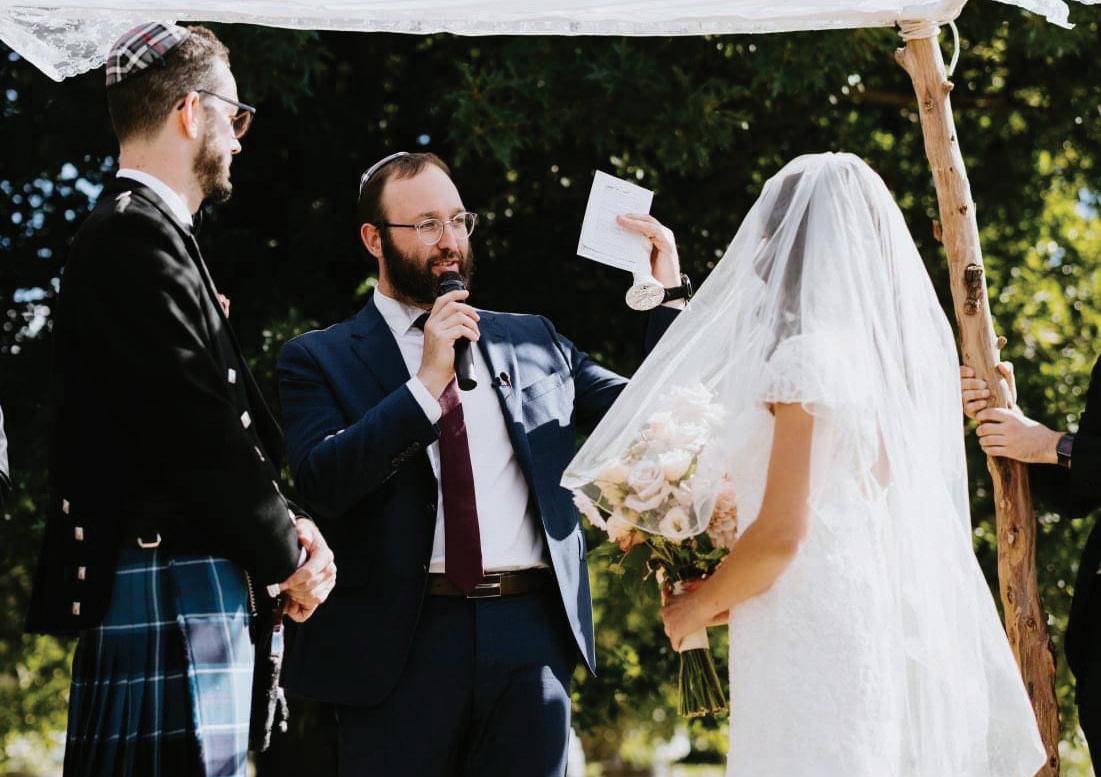
Toxic internet
BY RABBI GABI KALTMANN ARK CENTRE
If you ask any young person what is important to them and what keeps them up at night, you will receive a variety of answers. However, no doubt, there will be some commonalities in the responses. Young people are frequently focused on the environment and climate change. They recognise the need for gender equality. They want work flexibility and to be treated with respect. They crave meaningful relationships and authentic connections.
Young people are our future. That is the reason so many organisations invest in leadership programs for youth. As a relatively young rabbi of a large community and synagogue, I grapple with the question of how to engage the new generation that will be members of my shule. Growing up in the digital age has some benefits, including instant connection, free phone calls with family and friends on the other side of the world, and a limitless ability to learn from wherever you are.
However, with the growth of the internet has also come an explosion of antisemitism. Apps can’t or don’t control the endless diatribe of hate which would have young Jewish people believe they are merely privileged white people.
When Anne Frank began trending on Twitter a few months ago, it was the result of widespread discussion about whether her whiteness afforded her privilege. Despite the ridiculous premise of discussing whether a Holocaust victim who did not live to her 18th birthday and was murdered by the Germans was privileged, what occurred served a more sinister purpose.
Today, where trends dictate what people believe and traditional media is less important to a new generation, the truth can be difficult to spot. Youngsters are at the mercy of algorithms that result in more toxic information being presented to them.
Influencers on TikTok speak about the “algorithm” feed, whereby once you see one antisemitic video, a feedback loop gives you the next one and then the one after that and so on.
When young Jews absorb non-Jewish ideas about who Jews are, it sets a dangerous precedent. Often, nonJewish ideas about Judaism do not account for the historical persecution of Jews, the cultural context in which many Jews have emigrated, or even the fact that most Jews in the world today are Sephardic. Deeming Jews “white” and associating that with “white privilege” ignores the history of racism, persecution and deprivation that so many Jews have experienced.
When young people consume this information, it can be damaging. It can cut deeply and reinforce incorrect stereotypes that do not reflect the lived experiences of Jewish people over thousands of years. We have to fight back against these ideas. We have to educate youth about the rich and beautiful history of our People, our culture and our traditions. We want to harness the power and passion that youngsters have so they take pride in their religious beliefs and stand up for them.
The solution is to empower them. To make them confident in their Jewish identity. To teach them our rich history and to learn to spot false narratives about our people, reject them and have secure knowledge that being Jewish is something great and something to be proud of.
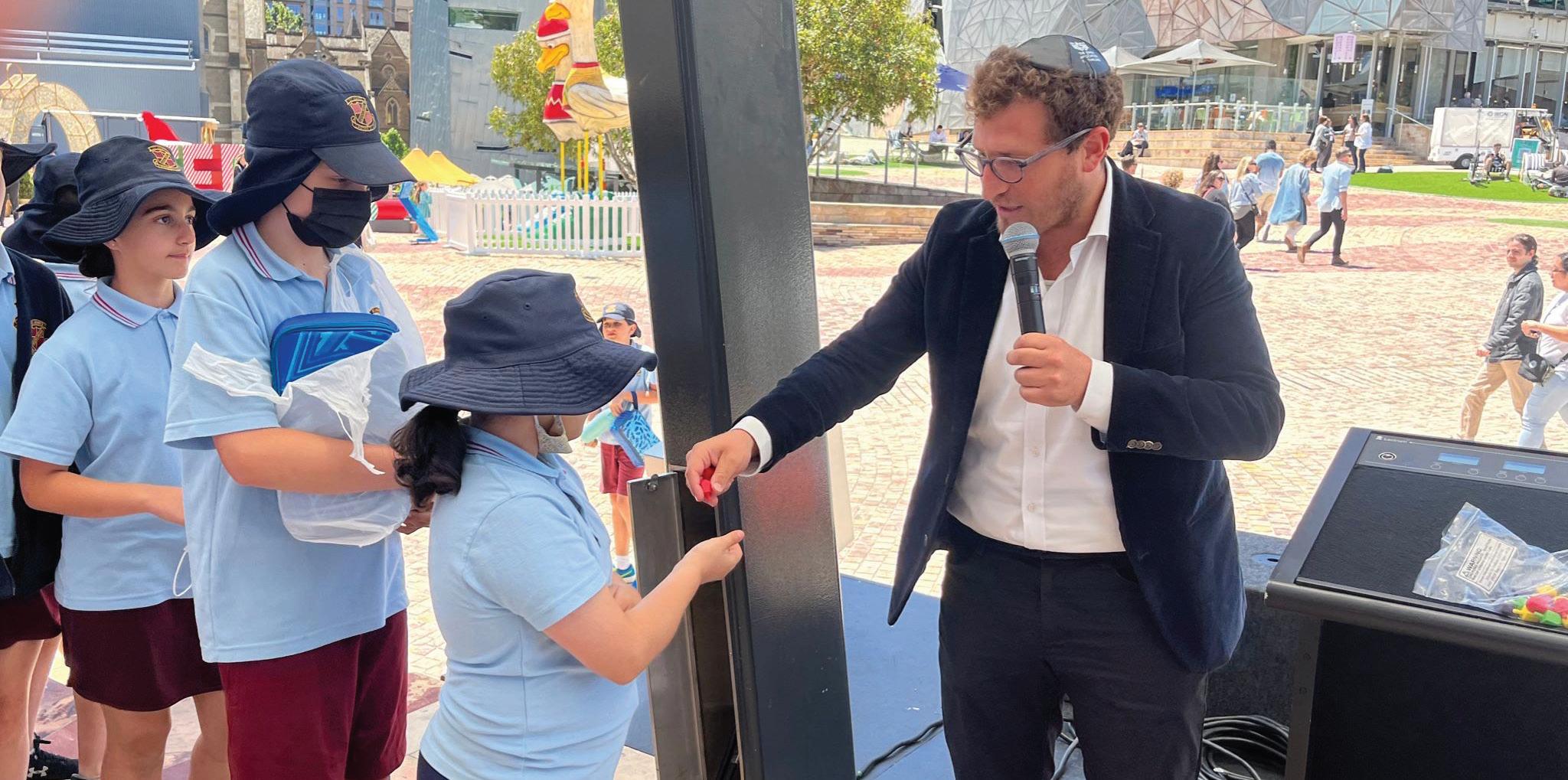
RABBINIC THOUGHT
BY RABBI DR BENJI LEVY
The Torah begins with a comprehensive, day-by-day recount of God’s creation of the universe. The Book of Genesis then goes on to detail the ten generations from Adam to Noah, from the birth of man in the ideal world of the Garden of Eden to his rapid descent into a spiritual abyss, far from the perfection into which he was born. The Torah illustrates this spiritual void into which the world descends in the story of Noah: “And God saw the Earth and behold it was corrupted, for all flesh had corrupted its way upon the Earth.” In response, God resolves to give the world a second chance at setting things straight. Noah is told that with the exception of himself, his family and enough animals to replenish the Earth, a flood will envelop and destroy the world. Yet, after being selected from the entire planet to be the single flame from which the rest of life will be rekindled and relaunch history, Noah the righteous man deteriorates into a simple man of the Earth.
“ … Noah was a righteous man (ish tzaddik), perfect in his generations; Noah walked with God.”[1] The Torah goes on to depict the floodwaters, a ritual bath of sorts for the entire world, cleansing the Earth of all its iniquity. The greatest universal calamity to have befallen humanity culminates in the first ever rainbow – a beautiful symbol of nature that represents God’s eternal covenant with mankind. The Torah then records a shameful event in which “Noah, the man of the earth (ish adama), debased himself and planted a vineyard”[2] leading to his intoxication and embarrassment. The same Noah who at the start of the parasha is referred to as an “ish tzaddik” is now referred to as an “ish adama” – a palpable contrast noted by the Midrash[3]. What does this difference in title imply?
The ish tzaddik lives for an ideal. Living in a community filled with promiscuity and despite the odds, Noah chooses to follow a code of moral behaviour. Over and above following the actual words of Torah, the ish tzaddik elevates what are seen as mundane experiences. He speaks, eats and conducts himself in venerable fashion. Man is a graft of animal and angel, and thus his challenge is to ensure that he does not descend to an animalistic level, but rather strives towards an angelic way of life. The ish adama, in contrast, is a man of the Earth, void of lofty ideals or aspirations to spiritually enhance his way of life.
Ironically, when Noah is challenged with the immense task of building and sustaining the ark, a microcosm of what will become the new world, he personifies the ish tzaddik. When, on the other hand, his task becomes less momentous as he re-enters daily life on the land, he simply plants grapes in the field and transitions into the more self-absorbed ish adama. The danger of Noah’s sin, in comparison to the very explicit sins that surround him in the generation of the flood, is in its subtlety. He is not morally degenerate, overly arrogant or a pagan wanderer, but simply an ish adama, a person devoid of ideals. So, too, a person’s greatest challenges often come when they are least expected, hidden among the seemingly most mundane moments. All Noah does is plant a vineyard, but it is the motivation behind this act that is central to his demise. He plants the vineyard in order to intoxicate himself and to take pleasure in meaningless behaviour. From Noah’s spiritual descent we can learn to avoid living life on a spiritual plateau, where there is no purpose other than to enjoy ourselves. Rather, we must continue to strive for more. God creates man “betzelem Elokim”,[4] in the image of God and in so doing provides us with inherent responsibility. At the very moment of our creation we were imbued with the responsibility to constantly strive for perfection and to continually try and emulate God, the epitome of perfection itself.
Often laid-back, easy-going societies are celebrated and envied. However, life cannot simply be built on satisfaction and enjoyment, for this leads to complacency and moral descent. Life must be fuelled by the fiery flames of the ideal human experience – one that embodies growth, yearning and striving for good.
Disengagement from his moral anchor causes Noah to drift and descend towards his ish adama status. The Hebrew term for conscience is matzpun, at the root of which is the term tzafon, meaning north. Embedded in the subtle magic of the Hebrew language lies Noah’s lesson for humankind. We must veer away from complacency and self-gratification, and rather allow our moral north to guide us, to help us elevate the mundane to the sacred and to help us identify right from wrong. Our routine must never consume our identity, but rather it should become the launching pad for greatness, from which we can work towards raising ourselves from a lifestyle of ish adama towards a level of ish tzaddik. [1] Genesis 6:9 [2] Genesis 9:20 [3] Midrash Tanchuma 3 [4] Genesis 1:27
Righteousness

Presenting a jam-packed program of over 50 of the best new Jewish-themed films from all across the world, the 2022 Jewish International Film Festival screens only in cinemas from October 24.
HIGHLIGHTS INCLUDE —
See Armageddon Time, starring Anthony Hopkins; comedy iMordecai, starring Judd Hirsch; or Mayim Bialik’s directorial debut, the family drama As They Made Us.
Classic Cinemas, Elsternwick and Lido Cinemas, Hawthorn
Book now at jiff.com.au











